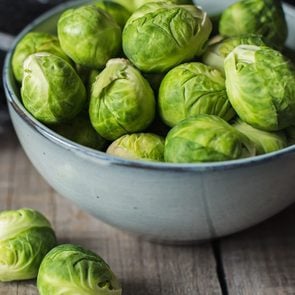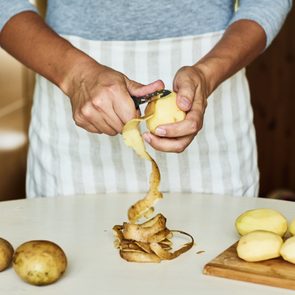Why sleep position matters for people with lower back pain
Back pain is a thief—it can rob you of your all-important zzz’s. The pain/no-sleep cycle is a vicious one and all too common for the 85 per cent of Canadians who will experience low back pain at some point in their lives, according to the Canadian Chiropractic Association.
Low back pain can be short-lived (lasting four to 12 weeks) or chronic (lasting 12 weeks or more), according to the Centers for Disease Control and Prevention. There are many possible causes, from fractures and muscle spasms to underlying diseases. And the pain may also travel with numbness or weakness if there is pressure on your nerves.
Whatever the cause, low back pain can make it hard to get comfy at night. And there are times when your pain will wake you—especially if you don’t snooze in the best sleeping position for lower back pain.
This lack of sleep makes the pain worse, says sleep medicine expert Raj Dasgupta, MD, an assistant professor of clinical medicine at the Keck School of Medicine at the University of Southern California in Los Angeles and a spokesperson for the American Academy of Sleep Medicine.
“Your sleep is less restorative,” he says. “If you get poor sleep, the pain will feel worse.” Sleep loss may impair healing or affect your mood, heightening pain sensitivity, or disrupting chemicals in the brain that are known to be involved in pain.

The best sleeping position for lower back pain
Finding the best sleep position for lower back pain may help you get a better night’s rest and relieve your pain, Dr. Dasgupta says.
This takes some trial and error. In general, “it is best to try to keep the normal curvature of your back when you sleep,” says Yili Huang DO, director of the Pain Management Center at Northwell Health’s Phelps Hospital in Sleepy Hollow, New York.
That said, there is no one-size-fits-all sleeping position for lower back pain, adds physical therapist Jake Magel, PhD, a research assistant professor at the University of Utah in Salt Lake City. “The best sleeping position is one that feels most comfortable for you,” he says.
Here are the best sleeping positions for lower back pain.
Back sleeping and low back pain
When sleeping on your back, try placing a pillow under your knees or a small pillow under your lower back, Dr. Huang suggests. This will support the natural curve of your spine and reduce pressure on your lower back.
Side sleeping and low back pain
When sleeping on your side, try putting a pillow between your legs, Huang suggests. Keeping your knees bent will reduce pressure on your lower spine, too.
Stomach sleeping and low back pain
When sleeping on your stomach, try placing a pillow under your lower abdomen to keep your spine more aligned and reduce pressure, Huang says. Dr. Dasgupta cautions it may be the worst possible sleep position if you have low back pain. “You have gravity pushing down, and this is not the way the spine should be aligned,” he says.
Sleeping on the best mattress for you counts, too, Dr. Dasgupta adds, noting that this is also a personal choice. “Firm and soft are relative terms,” he says. Remember to replace your mattress regularly. “Don’t wait until the springs start showing.” (Consult these mattress shopping tips before you buy.)
Treating your low back pain will also improve sleep. These expert-approved home remedies for back pain might help.
Good sleep hygiene and low back pain
Good sleep hygiene also plays a role, Dr. Dasgupta says. Keeping your bedroom cool and dark will promote sleep, he says.
This means limiting caffeine after 2 p.m. as it can keep you awake. Drinking alcohol may help you fall asleep, but you won’t stay that way for long, he says. Avoid engaging in stressful activities before bed, such as paying bills or scrolling through the news headlines. Instead, adopt a relaxing pre-bedtime ritual, Dr. Dasgupta says.
Sleep apnea, which is marked by pauses in breathing while sleeping, can sometimes travel with low back pain, he notes. The two conditions do share some risk factors, namely obesity. Some of the pain medications that treat low back pain also slow down breathing, which can worsen sleep apnea symptoms, he adds.
Getting a diagnosis and treating sleep apnea or any underlying sleep disorder will have spillover benefits for low back pain, he says.
Back sleeping may be best for pain, but it can make sleep apnea worse, he cautions. “Gravity causes your jaw, tongue, and soft palate to drop back toward your throat, narrowing the airways and leading to blocked airflow and trouble breathing,” Dr. Dasgupta explains.
The last word
Finding the best sleeping position for low back pain can help you get a better night’s sleep, resulting in spillover effects on your pain. Experiment with different positions and pillow placements to find one that works for you. And talk to your doctor to make sure you are doing everything possible to address the cause of your back pain. Now that you know the best sleeping position for lower back pain, check out 19 things you can do throughout the day for a better night’s sleep.
Distinct in many ways from the grocery store button variety, functional mushrooms have been used as herbal remedies and in daily tonics in Asian cultures for centuries. Now they’ve gone mainstream in North America, showing up in teas, tinctures and skin care. Functional mushrooms primarily grow on trees (versus in the ground) and have known benefits for the human body. Here’s how you can harness their powers for everyday use.
Reishi
Often referred to as the “queen of mushrooms,” reishi were once revered by royalty. Reishi mushrooms contain beta-glucans, a type of complex sugar that may help prevent the growth and spread of cancer cells. A few small studies have shown reishi can counteract the immune suppression caused by some cancer therapies, making them a good complement to treatments like chemotherapy and radiation. Reishi are also thought to produce feelings of relaxation and calm, so they are ideal as a nightcap. Try them in a tea before bed. (Check out more foods that may help prevent cancer.)
Lion’s Mane
Bright, brilliant white lion’s mane mushrooms get their name from their stringy, hair-like appearance. Touted for their neurological benefits, lion’s manes are thought to improve the mild impairment of cognitive function, including memory and thinking skills in older adults, and may help reduce mild symptoms of depression and anxiety. Lion’s mane also seems to protect the mucous membrane layer of the stomach, which can improve symptoms related to long-term inflammation of the stomach lining, like gastritis or stomach ulcers. Usually taken as a powder or capsule, lion’s mane is great as a caffeine substitute, as it can get your brain firing and improve your productivity—without the jitters. (Want to increase your daily intake of mushrooms? Try this tasty mushroom toast recipe.)
Chaga
Chaga mushrooms grow on birch trees and thrive in cold climates, like northern Canada, Siberia and northern Japan. Chaga look much different than other fungi because of their dark charcoal colour and coal-like shape. These fungi are high in antioxidants and have antimicrobial properties. Laboratory and animal studies show that compounds in chaga can kill cancer cells and stimulate the immune system. We’re just catching on to the chaga mushroom’s healing properties, but it’s been used as part of traditional medicine in Canadian Indigenous communities for generations. The mushrooms are typically ground into a powder and consumed as a tea or tincture. Have the drink as a daily tonic to protect against free radical damage and fend off infections. Because chaga is anti-inflammatory, it can also have positive skin effects and has popped up in skin-care products to soothe irritation and combat signs of aging. (Find out 11 more surprising things that can slow down aging.)
Cordyceps
Cordyceps are a unique type of parasitic fungus that grows out of the larvae of insects. The mushroom attacks the host and sprouts long, finger-like stems on the outside. Despite their aggressive tendencies, cordyceps are friend, not foe. Cordyceps have been a fixture in Chinese and Tibetan medicine for centuries and are sometimes referred to as “Himalayan Gold” for their reported performance-enhancing properties, like improving muscle endurance and sexual function. This effect occurs because cordyceps increase smooth muscle relaxation, which boosts blood flow to muscles and organs. Cordyceps are ideal for when you want to feel energized. Try them in a morning smoothie or drink to power through a workout or to conquer whatever else is on your to-do list for the day. (Discover more foods that can help improve circulation.)
The beauty of functional mushrooms is that they are intended for daily use, helping you adapt to whatever life throws your way. Whether you’re trying to find a moment of calm or looking for a way to support your immunity, multipurpose mushrooms are here to help.
Laura Jeha is a Registered Dietitian, nutrition counsellor, recipe developer and food writer living in Toronto. Find out more at ahealthyappetite.ca.
Next, check out the 50 best foods for your heart.

Fishing lessons from Petty Harbour
Fishing is part of my identity,” says Jasmine Paul, a 31-year-old part-time university student. “And when I wasn’t fishing, I was depressed.” On a Sunday in July, eight women are huddled together inside a wooden fishing shed in Petty Harbour, N.L., about a 15-minute drive south of St. John’s. As many as 20 girls and women spanning the ages 4 to 60 come out for the biweekly Girls Who Fish program, but today’s rain and fog has hampered the turnout.
“You weren’t being your true self,” Kimberly Orren replies. Orren, 54, along with her husband, Leo Hearn, founded Fishing for Success in Petty Harbour in 2014, a non-profit that celebrates and teaches the traditional fishing knowledge and skills that were once the mainstay of outport Newfoundland and Labrador. Since 2016, this has included a safe space for girls and women to talk about an industry that is male-dominated, and learn some practical skills needed to change that—all while catching a few cod.
Paul, who comes from a family of Newfoundland fishers, helped her parents with crabbing for a season in her early twenties, but decided to pursue academic studies. Ten years later, she realized she missed working outdoors with people she loves, and came back to it. She now aspires to one day skipper her own boat.
The idea for Fishing for Success came when Orren decided that she wanted to teach kids to fish. Raised in Newfoundland, she had moved to Florida as a teenager with her family in 1977. On her visits home to Petty Harbour, she witnessed the ongoing effect of fishery closures, as many people left their coastal homes.
“The community wharf wasn’t a community wharf anymore,” says Orren. She missed the days when kids waited dockside to earn a few bucks cutting cod tongues from discarded fish heads and selling them in town.
But Orren’s newfound purpose wasn’t only sentimental. Although there are fewer jobs in the fishery than there were during her childhood, the industry today hauls in more money than it has in generations, and for those who value the lifestyle, a career as a fisher is still a viable option.
To launch Fishing for Success, Orren traded one classroom for another, leaving a career as a high school science teacher in 2006 to head back to school herself—for graduate studies in fisheries and aquatic sciences, as well as a fishing industry diploma. Eight years later, her organization has passed on fishing knowledge and skills to thousands of kids, and also runs a program for families to learn together.
“Fishing for Success is drawing on sustainable fishing practices that date back 500 years,” says Dean Bavington, a professor of geography at Memorial University of Newfoundland, referring to techniques like handlining, where fishers use a line but no rod, pulling a bait of capelin up and down to attract cod. He adds that Orren’s organization goes one step further in reviving this heritage by bringing in individuals like Paul, who were historically excluded.
Back in the shed, the women talk at length about what fishing brings them. More than money from commercial trade or a recreational trophy, the vocation offers them sustenance and a connection to their birthplace. “We don’t have nans, pops, uncles and aunts who fish anymore,” Orren says. “We’ve got kids who live in Newfoundland who have never been on the water, never been in a boat.”
“Girls Who Fish reminds me I belong and have just as much right to discuss the issues in the fishery as anyone,” adds Paul. “It helps build my confidence and keeps me motivated to keep doing what I’m doing.”
Next, read about the bearded Newfoundland men who posed as mermaids—for a good cause!

 10 Medical Reasons Why You Can't Sleep" width="295" height="295" />
10 Medical Reasons Why You Can't Sleep" width="295" height="295" />





